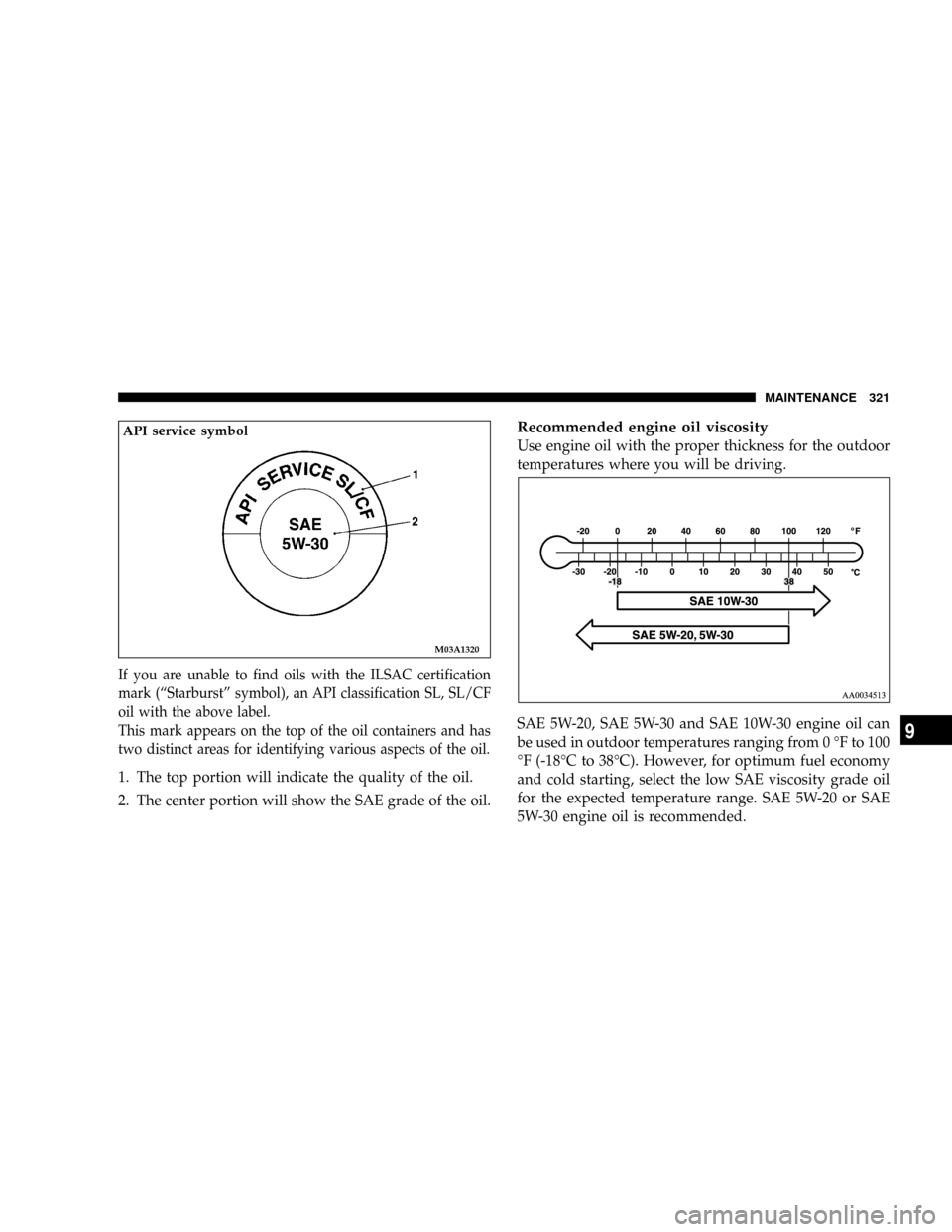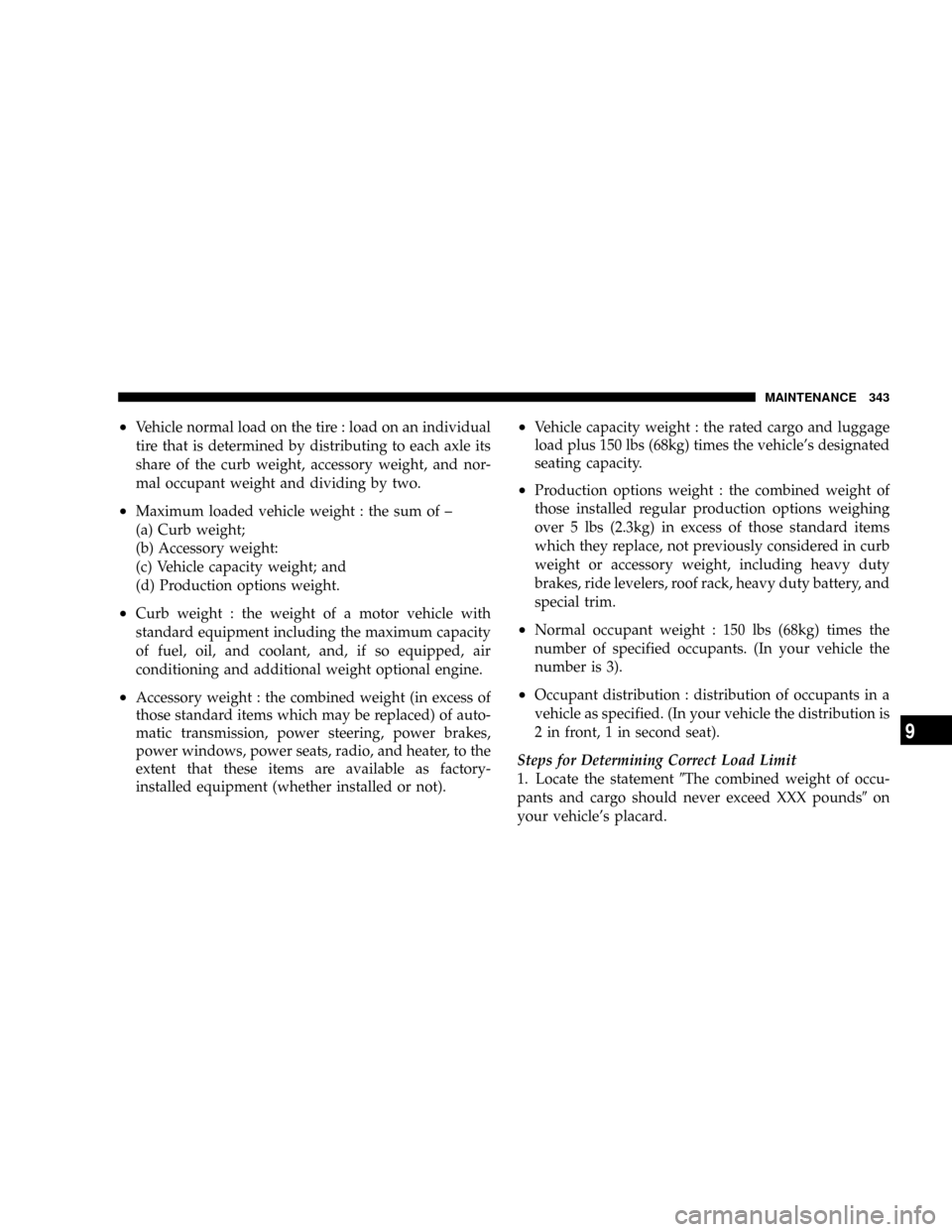2005 DODGE STRATUS COUPE engine oil
[x] Cancel search: engine oilPage 321 of 396

If you are unable to find oils with the ILSAC certification
mark (ªStarburstº symbol), an API classification SL, SL/CF
oil with the above label.
This mark appears on the top of the oil containers and has
two distinct areas for identifying various aspects of the oil.
1. The top portion will indicate the quality of the oil.
2. The center portion will show the SAE grade of the oil.
Recommended engine oil viscosity
Use engine oil with the proper thickness for the outdoor
temperatures where you will be driving.
SAE 5W-20, SAE 5W-30 and SAE 10W-30 engine oil can
be used in outdoor temperatures ranging from 0 ÉF to 100
ÉF (-18ÉC to 38ÉC). However, for optimum fuel economy
and cold starting, select the low SAE viscosity grade oil
for the expected temperature range. SAE 5W-20 or SAE
5W-30 engine oil is recommended.
M03A1320
API service symbol
MAINTENANCE 321
9
Page 322 of 396

ENGINE COOLANT
To check the coolant level
The coolant reserve system provides a quick visual
method for determining the coolant level. When the
engine is cold, the level of the coolant in the reserve tank
should be between the FULL and LOW marks. The
radiator normally remains completely full so there is no
need to remove the radiator cap except for checking the
coolant freeze point or replacing the antifreeze coolant.
To add coolant
Use DaimlerChrysler Genuine Coolant or an equivalent.
Genuine Coolant provides excellent protection against
corrosion and rust formation of all metals, including
aluminum, and prevents clogs in the radiator, heater,
cylinder head, engine block, etc.
If frequent coolant additions are required, or if the level
in the reserve tank does not drop when the engine cools,
the system should be pressure-tested for leaks. Take your
vehicle to an authorized dealer for inspection of the
cooling system.
CAUTION!
²Do not use alcohol or methanol anti-freeze or any
engine coolants mixed with alcohol or methanol
anti-freeze. The use of an improper anti-freeze can
cause corrosion of aluminum components.
²When additional coolant is needed to maintain
the proper level, a minimum of 50% concentration
of ethylene-glycol antifreeze in water should be
added to the reserve tank. Do not overfill. A
higher concentration (not to exceed 60%) should
be used if a lower freezing point is required. The
concentration level can be checked using instru-
ments available at automotive supply stores, or
can be done by your authorized dealer or service
station. Use only high quality ethylene-glycol
antifreeze coolant formulated to prevent corrosion
of all cooling system metals.
²Do not top off with water only. Water by itself
reduces the rust-protective and anti-freeze quali-
ties of the coolant and has a lower boiling point. It
can also cause damage to the cooling system if it
should freeze. Do not use tap water, as it may
cause corrosion and rust formation.
322 MAINTENANCE
Page 323 of 396

Radiator cap
The radiator cap must be fully tightened to prevent loss
of coolant and engine damage.
WARNING!
Make sure that the engine is thoroughly cooled
down before removing the radiator cap, otherwise
hot steam or boiling coolant may gush from the filler
port and scald you.
Points to remember
1. Do not overfill the reserve tank.
2. A special radiator cap is used to ensure sealing and to
allow the coolant to return from the reserve tank to the
radiator when the engine cools. If cap replacement is
necessary, use the proper cap.
3. Check the coolant freeze point in the radiator using
proper instruments, when it is safe to do so. If antifreeze
is added, the contents of the reserve tank must be
protected against freezing.
4. Keep the front of the radiator clean. Keep the front of
the condenser clean.5. If the temperature of the engine coolant does not rise
normally after engine warm-up, take the vehicle to an
authorized dealer to have the thermostat checked, and
replaced if necessary.
BRAKE FLUID
Recommended brake fluid conforming to DOT 3 or DOT 4
should be used. The reservoir cap must be fully tightened
to avoid contamination from foreign matter or moisture.
CAUTION!
²Do not allow petroleum-based fluid to contact,
mix with, or otherwise contaminate the brake
fluid. Seal damage will result.
²Take care in handling brake fluid as it may cause
damage to painted surfaces.
²Use only the specified brake fluid. Also, the
additives in different brands may result in a
chemical reaction when mixed together, so avoid
mixing different brands if possible.
²Keep the reservoir tank cap closed to prevent the
brake fluid from evaporating or absorbing moisture.
MAINTENANCE 323
9
Page 332 of 396

HOOD LOCK RELEASE MECHANISM AND
SAFETY CATCH
The door hinges, trunk hinges, hood lock release mecha-
nism and hood safety catch should be inspected, cleaned,
and lubricated as required to maintain ease of operation
and to provide protection against rust and wear. Apply
Multipurpose Grease NLGI Grade 2 sparingly to all
sliding contact areas of the hood latch and release lever.
Work lubricant into the hood lock mechanism until all
frictional surfaces are covered.
Also, apply a film of the same lubricant to the pivot
contact areas of the safety catch.
EXHAUST SYSTEM
WARNING!
Carbon monoxide gas found in the vehicle's exhaust
is poisonous. Inhalation of exhaust fumes can cause
unconsciousness or death.
The best protection against carbon monoxide entry into
the vehicle interior is a properly maintained engineexhaust system.
Whenever a change is noticed in the sound of the exhaust
system; when exhaust fumes can be detected inside the
vehicle; or when the underside or rear of the vehicle is
damaged, have a competent technician inspect the com-
plete exhaust system and adjacent body areas for broken,
damaged, deteriorated, or mispositioned parts.
In addition inspect the exhaust system each time the
vehicle is raised for lubrication or oil change. Replace as
required.
Open seams or loose connections could permit danger-
ous exhaust fumes to seep into the trunk and passenger
compartments.
Do this service when performing underbody service.
Check for any of the following conditions:
1. Check for holes or exhaust gas leakage caused by
corrosion or damage.
2. Check the joints and connections for looseness or
exhaust gas leakage.
3. Check the rubber hangers and brackets for damage.
332 MAINTENANCE
Page 343 of 396

²Vehicle normal load on the tire : load on an individual
tire that is determined by distributing to each axle its
share of the curb weight, accessory weight, and nor-
mal occupant weight and dividing by two.
²Maximum loaded vehicle weight : the sum of ±
(a) Curb weight;
(b) Accessory weight:
(c) Vehicle capacity weight; and
(d) Production options weight.
²Curb weight : the weight of a motor vehicle with
standard equipment including the maximum capacity
of fuel, oil, and coolant, and, if so equipped, air
conditioning and additional weight optional engine.
²Accessory weight : the combined weight (in excess of
those standard items which may be replaced) of auto-
matic transmission, power steering, power brakes,
power windows, power seats, radio, and heater, to the
extent that these items are available as factory-
installed equipment (whether installed or not).
²Vehicle capacity weight : the rated cargo and luggage
load plus 150 lbs (68kg) times the vehicle's designated
seating capacity.
²Production options weight : the combined weight of
those installed regular production options weighing
over 5 lbs (2.3kg) in excess of those standard items
which they replace, not previously considered in curb
weight or accessory weight, including heavy duty
brakes, ride levelers, roof rack, heavy duty battery, and
special trim.
²Normal occupant weight : 150 lbs (68kg) times the
number of specified occupants. (In your vehicle the
number is 3).
²Occupant distribution : distribution of occupants in a
vehicle as specified. (In your vehicle the distribution is
2 in front, 1 in second seat).
Steps for Determining Correct Load Limit
1. Locate the statement9The combined weight of occu-
pants and cargo should never exceed XXX pounds9on
your vehicle's placard.
MAINTENANCE 343
9
Page 349 of 396

REGULAR MAINTENANCE SCHEDULE
The content and mileage interval can vary depending on
model.
!6,000 Miles (10 000 km) or at 6 months
NChange engine oil and engine oil filter.
NRotate tires.
MILEAGE/
MONTHSDEALERSHIP
NAME/CODE DATEREPAIR
ORDER #
!12,000 Miles (19 000 km) or at 12 months
NCheck automatic transaxle fluid level.
NInspect disc brake pads, rotors and calipers for
wear and leaks.
NCheck brake hoses for deterioration or leaks.
NInspect drive shaft boots for grease leaks and
damage.
NChange engine oil and engine oil filter.
NRotate tires.
MILEAGE/
MONTHSDEALERSHIP
NAME/CODE DATEREPAIR
ORDER #
!18,000 Miles (29 000 km) or at 18 months
NChange engine oil and engine oil filter.
NRotate tires.
MILEAGE/
MONTHSDEALERSHIP
NAME/CODE DATEREPAIR
ORDER #
MAINTENANCE 349
9
Page 350 of 396

!24,000 Miles (38 000 km) or at 24 months
NCheck automatic transaxle fluid level.
NInspect disc brake pads, rotors and calipers for
wear and leaks.
NCheck brake hoses for deterioration or leaks.
NInspect drive shaft boots for grease leaks and
damage.
NChange engine oil and engine oil filter.
NRotate tires.
MILEAGE/
MONTHSDEALERSHIP
NAME/CODE DATEREPAIR
ORDER #
!30,000 Miles (48 000 km) or at 30 months
NReplace air cleaner filter.
NReplace spark plugs, standard type.
NCheck drive belts condition (for the generator,
water pump, power steering pump).
NCheck manual transaxle oil level.
NCheck coolant hoses (radiator hose, heater hose).
NCheck fuel hoses condition.
NInspect rear drum brake linings and rear wheel
cylinders (except vehicles with disc brakes) for
wear and leaks of all wheels.
NInspect ball joint and steering linkage seals for
grease leaks and damage.
NInspect suspension system for looseness and dam-
age.
NCheck and service exhaust system as required
(connection portion of muffler, muffler pipes and
converter heat shields).
MILEAGE/
MONTHSDEALERSHIP
NAME/CODE DATEREPAIR
ORDER #
350 MAINTENANCE
Page 351 of 396

!30,000 Miles (48 000 km) or at 30 months
NChange engine oil and engine oil filter.
NRotate tires.
MILEAGE/
MONTHSDEALERSHIP
NAME/CODE DATEREPAIR
ORDER #
!36,000 Miles (58 000 km) or at 36 months
NCheck automatic transaxle fluid level.
NInspect disc brake pads, rotors and calipers for
wear and leaks.
NCheck brake hoses for deterioration or leaks.
NInspect drive shaft boots for grease leaks and damage.
NChange engine oil and engine oil filter.
NRotate tires.
MILEAGE/
MONTHSDEALERSHIP
NAME/CODE DATEREPAIR
ORDER #
!42,000 Miles (67 000 km) or at 42 months
NChange engine oil and engine oil filter.
NRotate tires.
MILEAGE/
MONTHSDEALERSHIP
NAME/CODE DATEREPAIR
ORDER #
!48,000 Miles (77 000 km) or at 48 months
NCheck automatic transaxle fluid level.
NInspect disc brake pads, rotors and calipers for
wear.
NCheck brake hoses for deterioration or leaks.
NInspect drive shaft boots for grease leaks and
damage.
NChange engine oil and engine oil filter.
NRotate tires.
MILEAGE/
MONTHSDEALERSHIP
NAME/CODE DATEREPAIR
ORDER #
MAINTENANCE 351
9